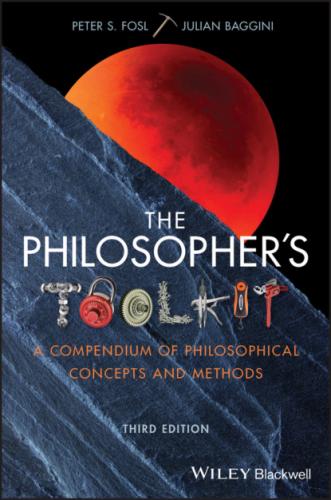Preface
Philosophy can be an extremely technical and complex affair, one whose terminology and procedures are often intimidating to the beginner and demanding even for the professional. Like that of surgery, the art of philosophy requires mastering a body of knowledge as well as acquiring precision and skill with a set of instruments or tools. The Philosopher’s Toolkit may be thought of as a collection of just such tools. Unlike those of a surgeon or a master woodworker, however, the instruments presented by this text are conceptual – tools that can be used to enter, analyse, criticise, and evaluate philosophical concepts, arguments, visions, and theories.
The Toolkit can be used in a variety of ways. It can be read cover to cover by those looking for instruction on the essentials of philosophical reflection. Or it can be used as a course book on basic philosophical method or critical thinking. It can also be used as a reference book to which general readers and more advanced philosophers can turn in order to find quick and clear accounts of the key concepts and methods of philosophy. The book is assembled so that there is a natural, logical order from start to finish, but one can also start wherever one likes, just as one might play any song on a record album first. The aim of the book, in other words, is to act as a conceptual toolbox from which all those from neophytes to master artisans can draw instruments that would otherwise be distributed over a diverse set of texts and require long periods of study to acquire.
For this third edition, we have expanded the book with sixteen new entries, and we’ve reviewed and revised most of the others. The book’s sections still progress from the basic tools of argumentation to more sophisticated philosophical concepts and principles. The text circulates through various instruments for assessment, essential laws, fundamental principles, and important conceptual distinctions. It concludes with a discussion of the limits of philosophical thinking. Through every chapter, the text opens entry points into complex topics of contemporary philosophical interest.
The Toolkit’s composition is intentionally pluralistic. By that we mean that we try to honour both the Continental and Anglo‐American traditions in philosophy. These two streams of Western philosophical thought have often been at odds, each regarding the other with critical suspicion and disdain. Though they have never been wholly distinct, the last major figure clearly rooting both is, arguably, eighteenth‐century philosopher Immanuel Kant (1724–1804). After Kant, the Continental tradition pursued lines of thinking charted through German and British idealism, phenomenology, existentialism, semiotics, structuralism, and various flavours of post‐structuralism, at times blending with literary criticism. Anglo‐American philosophy, in contrast, followed a course at first through empiricism, utilitarianism, and positivism, after which it then turned into pragmatism and analytic philosophy. This book is committed to the proposition that there is value in each tradition and that the richest and truest approach to philosophy draws from both.
The seven sections or chapters assembled here are composed of compact entries, each containing an explanation of the tool it addresses, examples of the tool in use, and guidance about the tool’s scope and limits. Each entry is cross‐referenced to other related entries – often in obvious ways but also sometimes in ways we think will be both novel and enlightening. Readers can chart their own path through the volume by following the cross‐references and recommended readings that interest them from one entry to the another. Recommended readings marked with an asterisk will be more accessible to readers and relatively less technical. There is also a list of Internet resources at the front of the book.
The readings we recommend are important recent and historical texts about which advanced readers ought to know. Recommended readings, however, also include introductory texts that will provide beginners with more extensive accounts of the relevant topic. Other recommended texts simply offer readers some indication of the range of import the topic has had.
Becoming a master sculptor requires more than the ability to pick up and use the tools of the trade: it requires talent, imagination, practice, persistence, and sometimes courage, too. In the same way, learning how to use these philosophical tools will not turn a beginner into a master of the art of philosophy overnight. What it will do is equip readers with skills, capacities, and techniques that will, we hope, help them philosophise better.
1 Basic Tools for Argument
1 1.1 Arguments, premises, and conclusions
11 1.11 Certainty and probability
12 1.12 Tautologies, self‐contradictions, and the law of non‐contradiction
1.1 Arguments, premises, and conclusions
Philosophy is for nit‐pickers. That’s not to say it is a trivial pursuit. Far from it. Philosophy addresses some of the most important questions human beings ask themselves. The reason philosophers are nit‐pickers is that they are commonly concerned with the ways in which the claims and beliefs people hold about the world either are or are not rationally supported, usually by rational argument. Because their concern is serious, it is important for philosophers to demand attention to detail. People reason in a variety of ways using a number of techniques, some legitimate and some not. Often one can discern the difference between good and bad reasoning only if one scrutinises the content and structure of arguments with supreme and uncompromising diligence.
Argument and inference
What, then, is an ‘argument’ proper? For many people, an argument is a contest or conflict between two or more people who disagree about something. An argument in this sense might involve shouting, name‐calling, and even a bit of shoving. It might also – but need not – include reasoning.
Philosophers,
